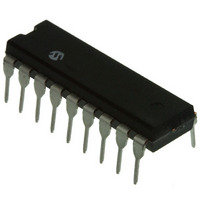PIC16F818-I/P Microchip Technology, PIC16F818-I/P Datasheet - Page 25

PIC16F818-I/P
Manufacturer Part Number
PIC16F818-I/P
Description
IC MCU FLASH 1KX14 18-DIP
Manufacturer
Microchip Technology
Series
PIC® 16Fr
Datasheets
1.PIC16F616T-ISL.pdf
(8 pages)
2.PIC16F688T-ISL.pdf
(688 pages)
3.PIC16F818-ISO.pdf
(176 pages)
4.PIC16F818-ISO.pdf
(6 pages)
5.PIC16F818-ISO.pdf
(8 pages)
6.PIC16F818-ISO.pdf
(8 pages)
Specifications of PIC16F818-I/P
Program Memory Type
FLASH
Program Memory Size
1.75KB (1K x 14)
Package / Case
18-DIP (0.300", 7.62mm)
Core Processor
PIC
Core Size
8-Bit
Speed
20MHz
Connectivity
I²C, SPI
Peripherals
Brown-out Detect/Reset, POR, PWM, WDT
Number Of I /o
16
Eeprom Size
128 x 8
Ram Size
128 x 8
Voltage - Supply (vcc/vdd)
4 V ~ 5.5 V
Data Converters
A/D 5x10b
Oscillator Type
Internal
Operating Temperature
-40°C ~ 85°C
Processor Series
PIC16F
Core
PIC
Data Bus Width
8 bit
Data Ram Size
128 B
Interface Type
I2C/SPI/SSP
Maximum Clock Frequency
20 MHz
Number Of Programmable I/os
16
Number Of Timers
3
Operating Supply Voltage
2 V to 5.5 V
Maximum Operating Temperature
+ 85 C
Mounting Style
Through Hole
3rd Party Development Tools
52715-96, 52716-328, 52717-734
Development Tools By Supplier
PG164130, DV164035, DV244005, DV164005, PG164120, ICE2000, DM163014
Minimum Operating Temperature
- 40 C
On-chip Adc
5-ch x 10-bit
Lead Free Status / RoHS Status
Lead free / RoHS Compliant
For Use With
ACICE0202 - ADAPTER MPLABICE 18P 300 MILAC164010 - MODULE SKT PROMATEII DIP/SOIC
Lead Free Status / Rohs Status
Lead free / RoHS Compliant
Available stocks
Company
Part Number
Manufacturer
Quantity
Price
Company:
Part Number:
PIC16F818-I/P
Manufacturer:
Microchip Technology
Quantity:
295
2.3
The Program Counter (PC) is 13 bits wide. The low
byte comes from the PCL register, which is a readable
and writable register. The upper bits (PC<12:8>) are
not readable but are indirectly writable through the
PCLATH register. On any Reset, the upper bits of the
PC will be cleared. Figure 2-5 shows the two situations
for the loading of the PC. The upper example in the
figure shows how the PC is loaded on a write to PCL
(PCLATH<4:0>
figure shows how the PC is loaded during a CALL or
GOTO instruction (PCLATH<4:3>
FIGURE 2-5:
2.3.1
A computed GOTO is accomplished by adding an offset
to the program counter (ADDWF PCL). When doing a
table read using a computed GOTO method, care
should be exercised if the table location crosses a PCL
memory boundary (each 256-byte block). Refer to the
application note AN556, “Implementing a Table Read”
(DS00556).
2.3.2
The PIC16F818/819 family has an 8-level deep x 13-bit
wide hardware stack. The stack space is not part of
either program or data space and the Stack Pointer is
not readable or writable. The PC is PUSHed onto the
stack when a CALL instruction is executed or an
interrupt causes a branch. The stack is POPed in the
event of a RETURN, RETLW or a RETFIE instruction
execution. PCLATH is not affected by a PUSH or POP
operation.
2004 Microchip Technology Inc.
PC
PC
12
12 11 10
2
PCL and PCLATH
PCH
5
PCLATH<4:3>
PCH
COMPUTED GOTO
STACK
PCLATH
PCLATH<4:0>
8
PCLATH
8
7
PCH). The lower example in the
7
LOADING OF PC IN
DIFFERENT SITUATIONS
PCL
PCL
11
8
PCH).
0
0
Instruction with
PCL as
Destination
ALU
GOTO,CALL
Opcode <10:0>
The stack operates as a circular buffer. This means that
after the stack has been PUSHed eight times, the ninth
push overwrites the value that was stored from the first
push. The tenth push overwrites the second push (and
so on).
2.4
The INDF register is not a physical register. Addressing
INDF actually addresses the register whose address is
contained in the FSR register (FSR is a pointer). This is
indirect addressing.
EXAMPLE 2-1:
Reading INDF itself indirectly (FSR = 0) will produce
00h. Writing to the INDF register indirectly results in a
no operation (although status bits may be affected).
A simple program to clear RAM locations, 20h-2Fh,
using indirect addressing is shown in Example 2-2.
EXAMPLE 2-2:
An effective 9-bit address is obtained by concatenating
the 8-bit FSR register and the IRP bit (Status<7>) as
shown in Figure 2-6.
• Register file 05 contains the value 10h
• Register file 06 contains the value 0Ah
• Load the value 05 into the FSR register
• A read of the INDF register will return the value
• Increment the value of the FSR register by one
• A read of the INDF register now will return the
NEXT
CONTINUE
Note 1: There are no status bits to indicate stack
of 10h
(FSR = 06)
value of 0Ah
2: There are no instructions/mnemonics
Indirect Addressing: INDF and
FSR Registers
:
MOVLW 0x20
MOVWF FSR
CLRF
INCF
BTFSS FSR, 4 ;all done?
GOTO
overflow or stack underflow conditions.
called PUSH or POP. These are actions
that occur from the execution of the
CALL, RETURN, RETLW and RETFIE
instructions or the vectoring to an
interrupt address.
PIC16F818/819
INDF
FSR
NEXT
INDIRECT ADDRESSING
HOW TO CLEAR RAM
USING INDIRECT
ADDRESSING
;initialize pointer
;to RAM
;clear INDF register
;inc pointer
;NO, clear next
;YES, continue
DS39598E-page 23















